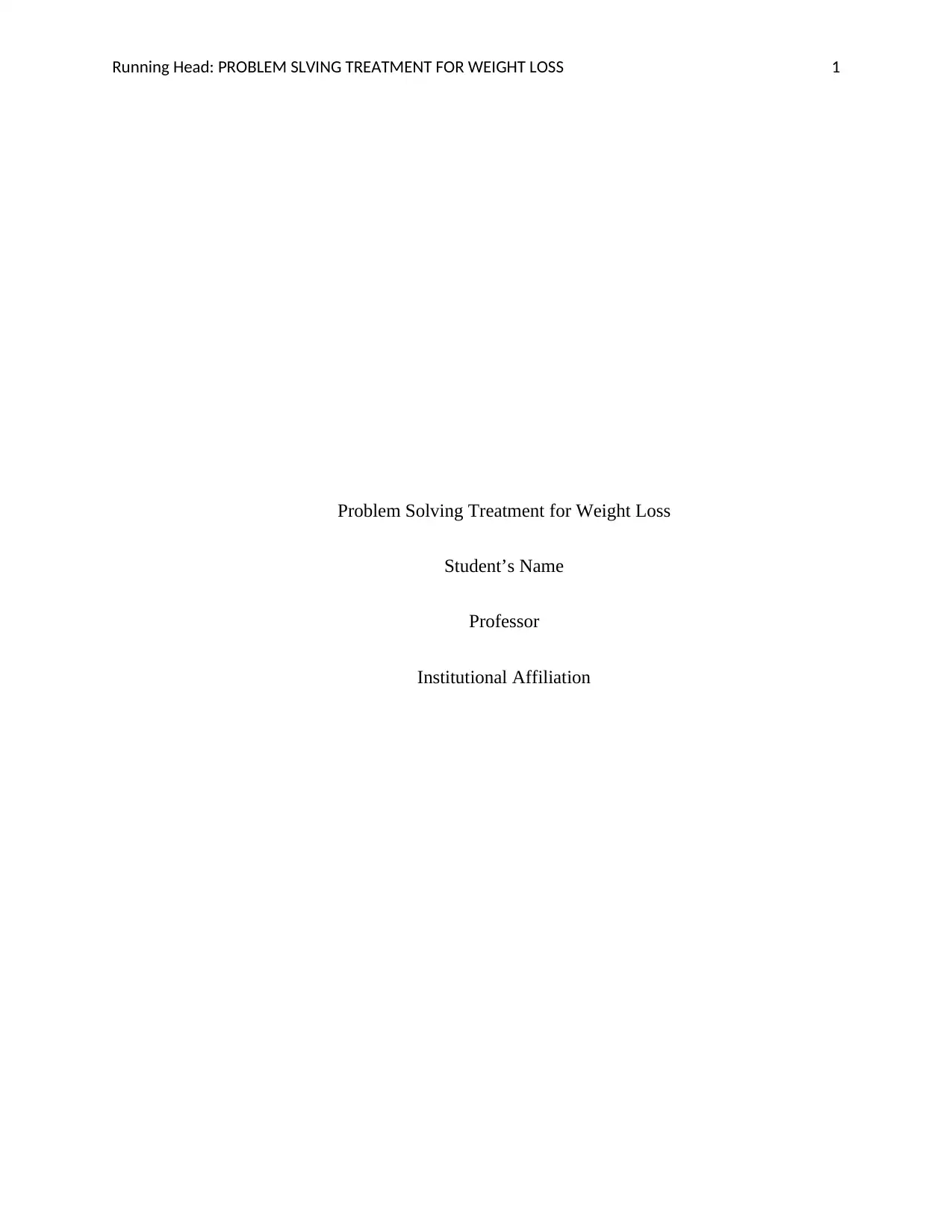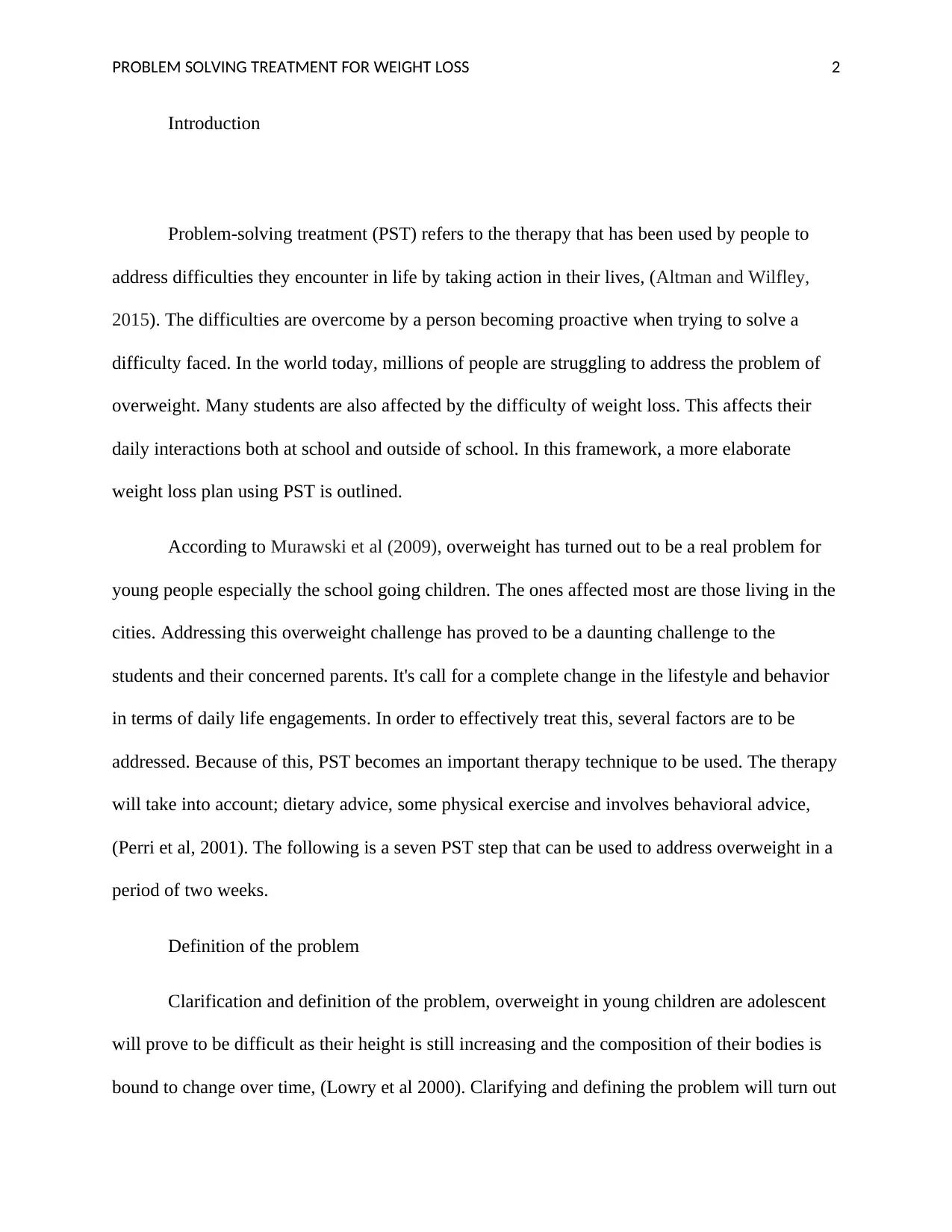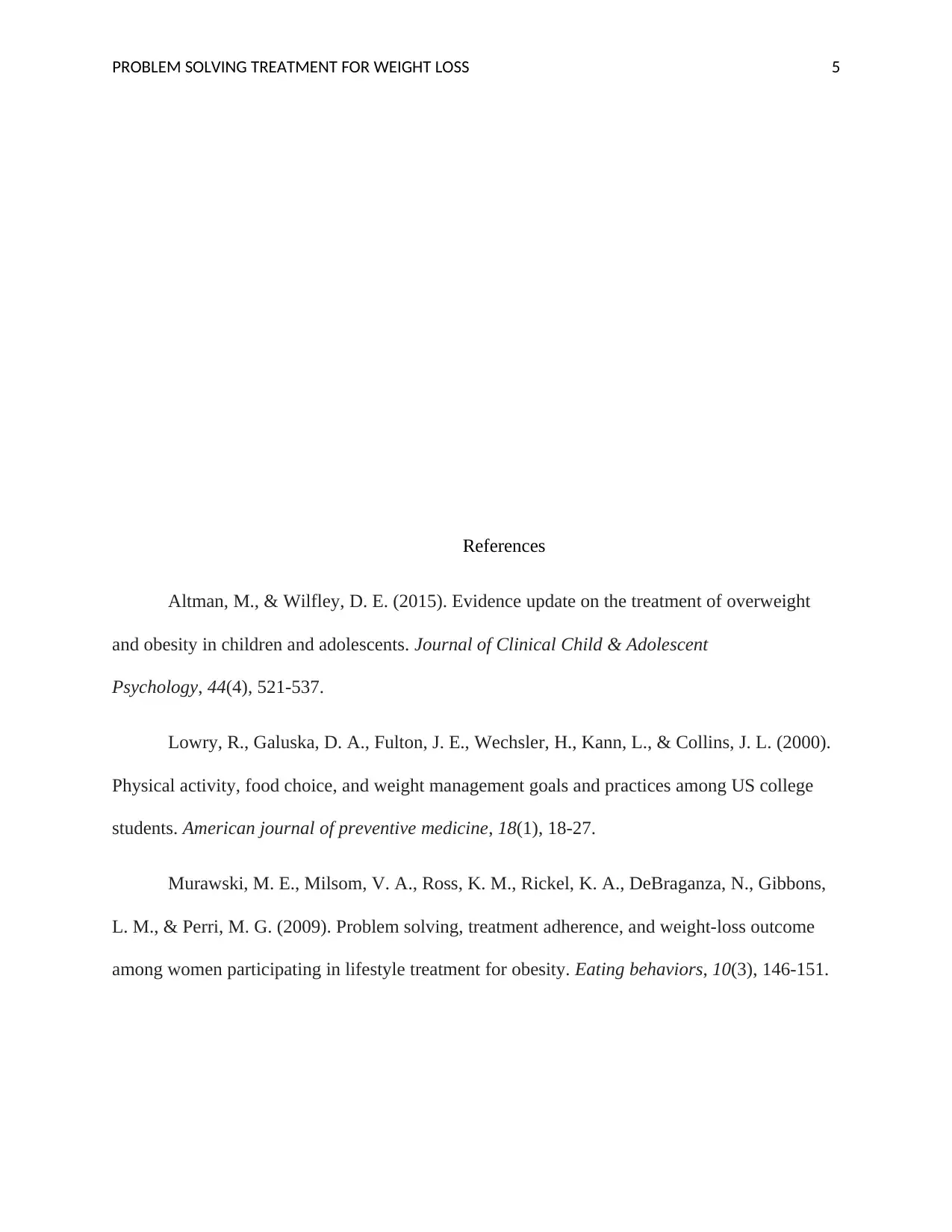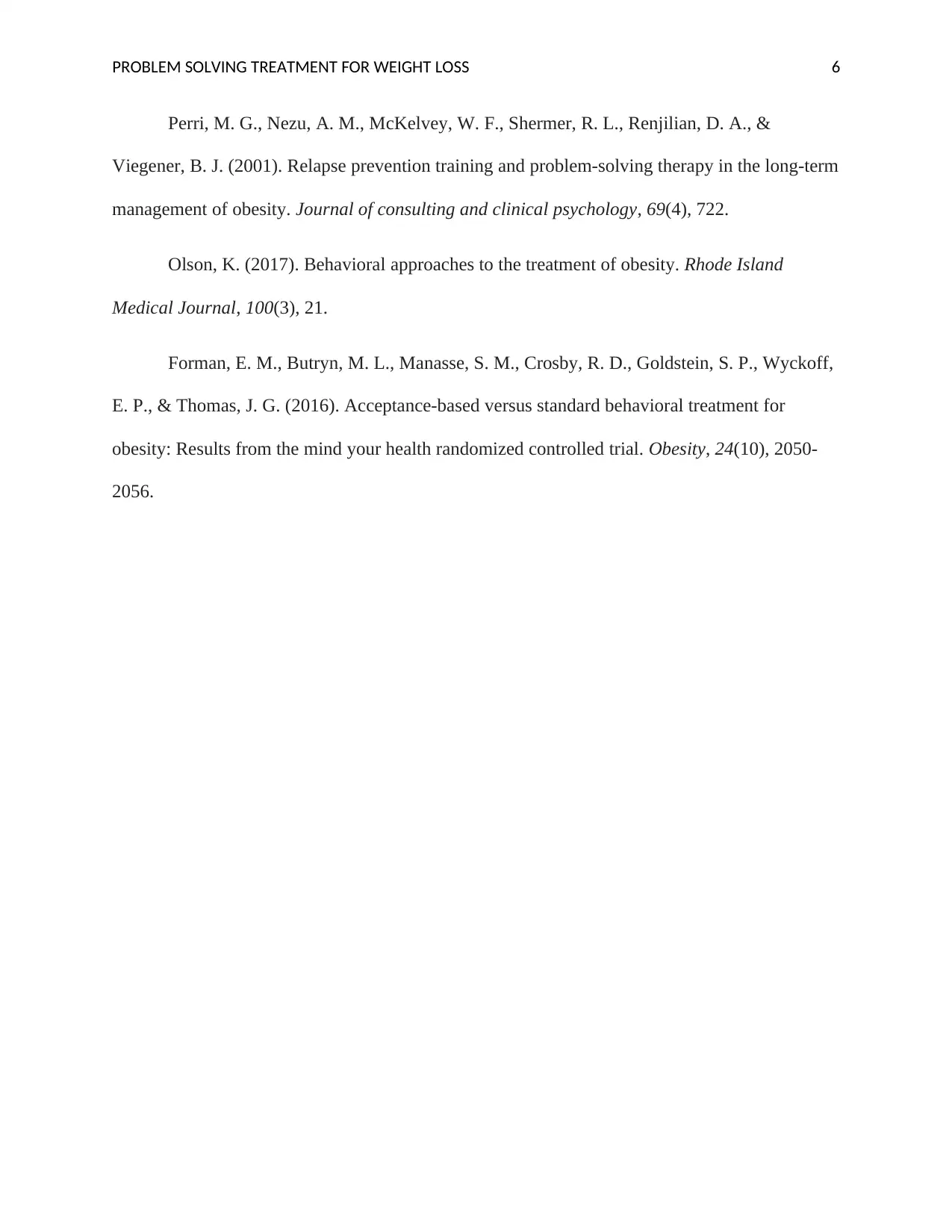Weight Loss Management: Problem-Solving Treatment Essay
VerifiedAdded on 2023/06/10
|6
|1310
|399
Essay
AI Summary
This essay details a problem-solving treatment (PST) approach for weight loss, specifically tailored for students. It outlines a seven-step PST strategy, including defining the problem (overweight), setting SMART goals (e.g., losing six pounds in two weeks), identifying strategies (diet, gym, jogging), evaluating feasibility, selecting the best approach (jogging and gym), creating an action plan (morning runs and evening gym sessions), and implementing/evaluating the plan. The essay emphasizes the importance of consistency and long-term maintenance for sustained weight loss and improved well-being. It also addresses the challenges of defining overweight in young people, uses BMI percentile for assessment, and references scholarly sources to support the PST framework. The chosen strategy of jogging and gym is highlighted as a feasible approach that improves physical appearance and blood flow, leading to improved concentration and grades. The essay concludes by underscoring the need for gradual and steady progress for sustained weight loss and better health.

Running Head: PROBLEM SLVING TREATMENT FOR WEIGHT LOSS 1
Problem Solving Treatment for Weight Loss
Student’s Name
Professor
Institutional Affiliation
Problem Solving Treatment for Weight Loss
Student’s Name
Professor
Institutional Affiliation
Paraphrase This Document
Need a fresh take? Get an instant paraphrase of this document with our AI Paraphraser

PROBLEM SOLVING TREATMENT FOR WEIGHT LOSS 2
Introduction
Problem-solving treatment (PST) refers to the therapy that has been used by people to
address difficulties they encounter in life by taking action in their lives, (Altman and Wilfley,
2015). The difficulties are overcome by a person becoming proactive when trying to solve a
difficulty faced. In the world today, millions of people are struggling to address the problem of
overweight. Many students are also affected by the difficulty of weight loss. This affects their
daily interactions both at school and outside of school. In this framework, a more elaborate
weight loss plan using PST is outlined.
According to Murawski et al (2009), overweight has turned out to be a real problem for
young people especially the school going children. The ones affected most are those living in the
cities. Addressing this overweight challenge has proved to be a daunting challenge to the
students and their concerned parents. It's call for a complete change in the lifestyle and behavior
in terms of daily life engagements. In order to effectively treat this, several factors are to be
addressed. Because of this, PST becomes an important therapy technique to be used. The therapy
will take into account; dietary advice, some physical exercise and involves behavioral advice,
(Perri et al, 2001). The following is a seven PST step that can be used to address overweight in a
period of two weeks.
Definition of the problem
Clarification and definition of the problem, overweight in young children are adolescent
will prove to be difficult as their height is still increasing and the composition of their bodies is
bound to change over time, (Lowry et al 2000). Clarifying and defining the problem will turn out
Introduction
Problem-solving treatment (PST) refers to the therapy that has been used by people to
address difficulties they encounter in life by taking action in their lives, (Altman and Wilfley,
2015). The difficulties are overcome by a person becoming proactive when trying to solve a
difficulty faced. In the world today, millions of people are struggling to address the problem of
overweight. Many students are also affected by the difficulty of weight loss. This affects their
daily interactions both at school and outside of school. In this framework, a more elaborate
weight loss plan using PST is outlined.
According to Murawski et al (2009), overweight has turned out to be a real problem for
young people especially the school going children. The ones affected most are those living in the
cities. Addressing this overweight challenge has proved to be a daunting challenge to the
students and their concerned parents. It's call for a complete change in the lifestyle and behavior
in terms of daily life engagements. In order to effectively treat this, several factors are to be
addressed. Because of this, PST becomes an important therapy technique to be used. The therapy
will take into account; dietary advice, some physical exercise and involves behavioral advice,
(Perri et al, 2001). The following is a seven PST step that can be used to address overweight in a
period of two weeks.
Definition of the problem
Clarification and definition of the problem, overweight in young children are adolescent
will prove to be difficult as their height is still increasing and the composition of their bodies is
bound to change over time, (Lowry et al 2000). Clarifying and defining the problem will turn out

PROBLEM SOLVING TREATMENT FOR WEIGHT LOSS 3
to be a tricky task. In order to determine overweight, the BMI percentile technique has been
adopted in the recent past as it measures the adiposity present in the students. Students with a
BMI percentile of over 25kg/m2 are considered to be overweight. The problem to be addressed
using the PST therapy is, therefore, to help a student with a BMI percentile value of over
25kg/m2, (Olson, 2017).
Setting of goals
The second step is setting realistic goals. For one to be successful in weight loss exercise,
one has to have an idea of what to do, Forman et al (2016). Weight loss goals should always be
SMART; Specific, Measurable, Attainable, Relevant and should have a Timeframe. In a span of
two weeks, a target of losing six pounds is SMART. Weight loss is a gradual and long-term
engagement and hence small targets are set to be met over time.
Strategies to achieve the goal
After setting the goal to be achieved in two weeks time, several plans can help achieve it.
Plans to help attain the weight loss are; going on diet, registering to a gym, making morning and
evening jogs or opting for weight loss medication. In this step of SPT, several weight loss plans
are listed so as one can have varied options to choose from.
Plan evaluation
Evaluation of plans, evaluation of plans is important to choose the best and the most
effective in order to achieve the set goal. Weight loss medication, there are pills on the market
today that help in weight loss. Most of them are prescribed by doctors to people who have
reached the obesity state. Those with complications related to weight such as high blood
to be a tricky task. In order to determine overweight, the BMI percentile technique has been
adopted in the recent past as it measures the adiposity present in the students. Students with a
BMI percentile of over 25kg/m2 are considered to be overweight. The problem to be addressed
using the PST therapy is, therefore, to help a student with a BMI percentile value of over
25kg/m2, (Olson, 2017).
Setting of goals
The second step is setting realistic goals. For one to be successful in weight loss exercise,
one has to have an idea of what to do, Forman et al (2016). Weight loss goals should always be
SMART; Specific, Measurable, Attainable, Relevant and should have a Timeframe. In a span of
two weeks, a target of losing six pounds is SMART. Weight loss is a gradual and long-term
engagement and hence small targets are set to be met over time.
Strategies to achieve the goal
After setting the goal to be achieved in two weeks time, several plans can help achieve it.
Plans to help attain the weight loss are; going on diet, registering to a gym, making morning and
evening jogs or opting for weight loss medication. In this step of SPT, several weight loss plans
are listed so as one can have varied options to choose from.
Plan evaluation
Evaluation of plans, evaluation of plans is important to choose the best and the most
effective in order to achieve the set goal. Weight loss medication, there are pills on the market
today that help in weight loss. Most of them are prescribed by doctors to people who have
reached the obesity state. Those with complications related to weight such as high blood
⊘ This is a preview!⊘
Do you want full access?
Subscribe today to unlock all pages.

Trusted by 1+ million students worldwide

PROBLEM SOLVING TREATMENT FOR WEIGHT LOSS 4
pressure. The most common drugs are orlistat, belviq and contrive. Going on diet, (Altman and
Wilfley, 2015)
Going on diet and cutting the intake of foods with lots of calories is another plan of
losing weight. The most important part of this is cutting on carbohydrates. Fewer carbohydrates
intake reduces one's hunger levels leading to one intake of fewer calories. Starvation of
carbohydrates will make the body start feeding on the stored fat.
Gym, morning and evening jog. Involving in vigorous exercise compels the body to burn
calories stored to provide the energy required in the exercise. Over time the physical condition
will be improved and in the process, weight is lost.
Best strategy
Jogging and going to the gym is the most appropriate means of weight loss among
students. This improves the physical appearance, blood flow on top of losing weight. it is the
most feasible plan that will improve the wellbeing of the student over time.
Action plan and implementation
Since the student will be going to school, he or she will set up sometime in the morning
to go for a 2km morning run before going to school. In the evening after school, he or she can go
to the gym for aerobics and light weight lifting.
With determination and consistency in honoring the set timetable, the set goal of losing
6kgs in two weeks is achieved. The road to losing weight gets on the steady gradual road. The
student loses the weight, improves the blood flow improving concentration leading to improved
grades.
pressure. The most common drugs are orlistat, belviq and contrive. Going on diet, (Altman and
Wilfley, 2015)
Going on diet and cutting the intake of foods with lots of calories is another plan of
losing weight. The most important part of this is cutting on carbohydrates. Fewer carbohydrates
intake reduces one's hunger levels leading to one intake of fewer calories. Starvation of
carbohydrates will make the body start feeding on the stored fat.
Gym, morning and evening jog. Involving in vigorous exercise compels the body to burn
calories stored to provide the energy required in the exercise. Over time the physical condition
will be improved and in the process, weight is lost.
Best strategy
Jogging and going to the gym is the most appropriate means of weight loss among
students. This improves the physical appearance, blood flow on top of losing weight. it is the
most feasible plan that will improve the wellbeing of the student over time.
Action plan and implementation
Since the student will be going to school, he or she will set up sometime in the morning
to go for a 2km morning run before going to school. In the evening after school, he or she can go
to the gym for aerobics and light weight lifting.
With determination and consistency in honoring the set timetable, the set goal of losing
6kgs in two weeks is achieved. The road to losing weight gets on the steady gradual road. The
student loses the weight, improves the blood flow improving concentration leading to improved
grades.
Paraphrase This Document
Need a fresh take? Get an instant paraphrase of this document with our AI Paraphraser

PROBLEM SOLVING TREATMENT FOR WEIGHT LOSS 5
References
Altman, M., & Wilfley, D. E. (2015). Evidence update on the treatment of overweight
and obesity in children and adolescents. Journal of Clinical Child & Adolescent
Psychology, 44(4), 521-537.
Lowry, R., Galuska, D. A., Fulton, J. E., Wechsler, H., Kann, L., & Collins, J. L. (2000).
Physical activity, food choice, and weight management goals and practices among US college
students. American journal of preventive medicine, 18(1), 18-27.
Murawski, M. E., Milsom, V. A., Ross, K. M., Rickel, K. A., DeBraganza, N., Gibbons,
L. M., & Perri, M. G. (2009). Problem solving, treatment adherence, and weight-loss outcome
among women participating in lifestyle treatment for obesity. Eating behaviors, 10(3), 146-151.
References
Altman, M., & Wilfley, D. E. (2015). Evidence update on the treatment of overweight
and obesity in children and adolescents. Journal of Clinical Child & Adolescent
Psychology, 44(4), 521-537.
Lowry, R., Galuska, D. A., Fulton, J. E., Wechsler, H., Kann, L., & Collins, J. L. (2000).
Physical activity, food choice, and weight management goals and practices among US college
students. American journal of preventive medicine, 18(1), 18-27.
Murawski, M. E., Milsom, V. A., Ross, K. M., Rickel, K. A., DeBraganza, N., Gibbons,
L. M., & Perri, M. G. (2009). Problem solving, treatment adherence, and weight-loss outcome
among women participating in lifestyle treatment for obesity. Eating behaviors, 10(3), 146-151.

PROBLEM SOLVING TREATMENT FOR WEIGHT LOSS 6
Perri, M. G., Nezu, A. M., McKelvey, W. F., Shermer, R. L., Renjilian, D. A., &
Viegener, B. J. (2001). Relapse prevention training and problem-solving therapy in the long-term
management of obesity. Journal of consulting and clinical psychology, 69(4), 722.
Olson, K. (2017). Behavioral approaches to the treatment of obesity. Rhode Island
Medical Journal, 100(3), 21.
Forman, E. M., Butryn, M. L., Manasse, S. M., Crosby, R. D., Goldstein, S. P., Wyckoff,
E. P., & Thomas, J. G. (2016). Acceptance‐based versus standard behavioral treatment for
obesity: Results from the mind your health randomized controlled trial. Obesity, 24(10), 2050-
2056.
Perri, M. G., Nezu, A. M., McKelvey, W. F., Shermer, R. L., Renjilian, D. A., &
Viegener, B. J. (2001). Relapse prevention training and problem-solving therapy in the long-term
management of obesity. Journal of consulting and clinical psychology, 69(4), 722.
Olson, K. (2017). Behavioral approaches to the treatment of obesity. Rhode Island
Medical Journal, 100(3), 21.
Forman, E. M., Butryn, M. L., Manasse, S. M., Crosby, R. D., Goldstein, S. P., Wyckoff,
E. P., & Thomas, J. G. (2016). Acceptance‐based versus standard behavioral treatment for
obesity: Results from the mind your health randomized controlled trial. Obesity, 24(10), 2050-
2056.
⊘ This is a preview!⊘
Do you want full access?
Subscribe today to unlock all pages.

Trusted by 1+ million students worldwide
1 out of 6
Related Documents
Your All-in-One AI-Powered Toolkit for Academic Success.
+13062052269
info@desklib.com
Available 24*7 on WhatsApp / Email
![[object Object]](/_next/static/media/star-bottom.7253800d.svg)
Unlock your academic potential
Copyright © 2020–2025 A2Z Services. All Rights Reserved. Developed and managed by ZUCOL.




